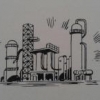Navneet2109:
Once you give our members the needed and important details on your application, you find that you start to obtain expert and experienced advice from them.
Your data starts to tell us most of the vital details (although not all of them). I fail to see what you are "giving up" by simply disclosing what you are trying to do. Our members need this information to accurately and clearly furnish help. By using your common sense and knowledge of your application you can easily arrive at what would be considered necessary dimensions for your inlet and outlet liquid propane nozzles for your spherical storage tank.
Firstly, you are storing a fairly large amount and you require large filling flow rates. If you are a chemical engineer, you will recognize that you are dealing with saturated, atmospheric temperature liquid propane and, as such, you are not depending on having to refrigerate the contents. You merely are required to transfer the liquid from supply sources (ships, tank cars, rail cars, etc.) into the tank for storage. Common sense should tell you that all that is required is knowledge of how you propose to make the transfer: by pump, compressor displacement, or other means. That should specify to you what are the critical flow criteria you must take into consideration - such as the pressure drops involved or allowed. This should indicate to you, complete with the design flow velocity you want (or need) to use in the associated piping and nozzles. Your data sheet, for example cites 500 m3/hr (= 2,200 gpm = 4.9 ft3/sec) of inlet flow rate and using a 10", sch 60 pipe nozzle yields an average flow velocity of 9.5 ft/sec. This is a normal, conventional flow velocity used in most applications. HOWEVER, we don't know if this suits your transfer piping requirements. You have to do the necessary piping calculations to ensure you get the proper pressure drop and flow rate with your supplied driving force. The same logic applies to the outlet nozzle, where you might have to satisfy a NPSH requirement for a transfer pump if you are feeding a system above the storage pressure conditions.
You failed to tell us if your query is regarding an existing, planned, proposed, or designed installation and that is essentially what Bobby is trying to get across to you: you have to take all of your project's scope of work into consideration and ensure you comply with what you have available and what you additionally need to conform to the needs. That is why he asks if you have any existing problems. He doesn't know if the installation exists or is being proposed or designed. He needs more information in order to help out.
Fallah is precisely correct also. With data sheet information he also now knows what you are trying to design and that you require no refrigeration. (I assume you are aware of what type of refrigeration we refer to with propane storage and transfer operations). His recommendation of employing a dip pipe to fill the tank is a normal, valid one. This is done to avoid the generation of static electrical charges when dealing with hydrocarbon liquids free-falling into a tank. In this case, the tank is a closed system and the hazard of having oxygen present is not there; however, the dip pipe serves as a means also to avoid any splashing and contents' movement and agitation which could affect steady level readings in your level control instruments. I consider it good practice; others may not care to use the dip pipe. (Don't forget to use a small, drilled hole at the top of the dip pipe to break a potential syphon action)
Answers I offer to your specific questions are:
1. Why distributor is necessary ?? In your application there seems to be no logical reason to use a distributor inside the tank. I don't recognize any reason for it. If you are a chemical engineer, that is YOUR process decision to make and specify to the mechanical engineer that will mechanically design the tank. It is not the other way around, where the mechanical engineer is making process decisions. That is also why YOU have to specify the size of the nozzles.
2. How to calculate distributor size??? Is there any reference?? any formula??? There is no such "formula" - just common fluid mechanics sense. Since you don't specify how you intend to transfer the propane and the allowable pressure drop as well as other constraints in the fill piping, there isn't much more to add.

 FB
FB

















